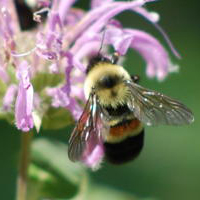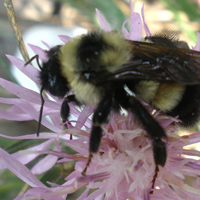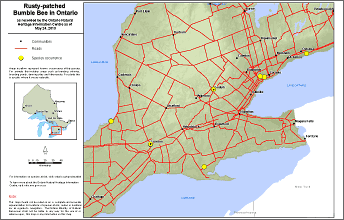Rusty-patched bumble bee
Scientific name: Bombus affinis



Cover photos credit: Johanna James-Heinz
Status
Endangered
'Endangered' means the species lives in the wild in Ontario but is facing imminent extinction or extirpation.
Date added to the Species at Risk in Ontario List
September 28, 2010
Read the Assessment Report
What it looks like
The Rusty-patched bumble bee is a medium to large bee, ranging from about one to two centimetres long with queens being at the higher end of this range.
Like most bumble bees, it is yellow and black, but males and workers have a distinctive rusty-coloured patch on the second segment of the abdomen. This bumble bee lives on the pollen and nectar of a wide variety of flowering plants.
Where it lives
This species, like other bumble bees, can be found in open habitat such as mixed farmland, urban settings, savannah, open woods and sand dunes.
The most recent sightings have been in oak savannah, which contains both woodland and grassland flora and fauna.
Where it’s been found in Ontario
The Rusty-patched bumble bee was once widespread and common in eastern North America, found from southern Ontario south to Georgia and west to the Dakotas.
The species has suffered rapid, severe decline throughout its entire range since the 1970s with only a handful of specimens collected in recent years in Ontario.
The only sightings of this bee in Canada since 2002 have been at The Pinery Provincial Park on Lake Huron.
View a Larger version of this map (PDF)
What threatens it
The cause of the decline of the Rusty-patched bumble bee is unknown.
Suspected causes include pesticide use and the spread of disease from bumble bees used to pollinate greenhouse vegetable crops.
Threats to remaining populations include habitat loss and potentially climate change.
Action we are taking
Endangered Species and their general habitat are automatically protected.
Recovery strategy
A recovery strategy advises the ministry on ways to ensure healthy numbers of the species return to Ontario.
Read the executive summary (December 7, 2011)
Read the recovery strategy (December 7, 2011)
Government response statement
A government response statement outlines the actions the government intends to take or support to help recover the species.
Read the government response statement (May 24, 2012)
Five-year review of progress
A five-year review of progress made toward protecting and recovering a species is required no later than five years after the government response statement for that species is published.
Read the report on progress towards the protection and recovery of six species at risk, including Rusty-patched Bumble Bee (2017).
Habitat protection
A habitat regulation defines a species' habitat and many describe features (e.g., a creek, cliff, or beach), geographic boundaries or other unique characteristics.
Read the habitat summary (January 1, 2014)
What you can do
Report a sighting
Report a sighting of an endangered animal or plant to the Natural Heritage Information Centre. Photographs with specific locations or mapping coordinates are always helpful.
Volunteer
Volunteer with your local nature club or provincial park to participate in surveys or stewardship work focused on species at risk.
Be a good steward
- private land owners have a very important role to play in species recovery; if you find the Rusty-patched bumble bee on your land, you may be eligible for stewardship programs that support the protection and recovery of species at risk and their habitats
- pollinators, such as bees, are in steep decline across the globe and they play a key role in the survival of many of Ontario’s rare plants; for information on how you can help scientists monitor pollinator populations in Ontario visit:
www.seeds.ca/proj/poll - to provide nectar and pollen for bumble bees, plant a variety of native flowering plants in your garden; bees tend to prefer pink, purple, and yellow flowers and need food from early spring to late fall
Report illegal activity
Report any illegal activity related to plants and wildlife to
Quick facts
- the Rusty-patched bumble bee gets nectar from flowers by biting a hole in the outside of it and sucking up the nectar with its tongue; this behaviour, called 'nectar-robbing', leaves marks on the flower than can help researchers detect the bees' presence in an area
- bumble bees perform 'buzz pollination', in which the bee grabs the pollen-producing structure of the flower in its jaws and vibrates its wing musculature, causing vibrations that dislodge pollen that would have otherwise remained trapped in the flower; some plants, including tomatoes, peppers, and cranberries, require buzz pollination
- bumble bees are different from other bees because they are large, fuzzy and carry pollen in 'pollen baskets' on their hind legs
- while female bumble bees can sting, they are quite docile and will only sting if their colony is disturbed or they are cornered
